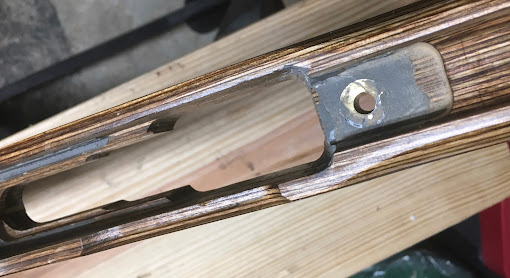Back in the early days of this blog I wrote about my .380 Walther PPK built under license by Smith & Wesson. I've always been a big fan of the PP and its various derivatives, as it was the model for so many guns that followed. All the Russian Makarov autos are really clones of the PPK as are just about every other fixed barrel double/single auto pistol. But as much as I liked it, I sold the PPK as I just couldn't get used to the sharp recoil. The PPK was designed around the .32 ACP (aka 7.62 auto pistol) and that's the best cartridge for that gun.
I've been looking for a .32 PPK since then, and then the other day I spotted what turned out to be a used PPK/S in .22 at a very attractive price- and in what looked like unused condition. This is a relatively recent gun from Walther that differs from the earlier .22 PP-type pistols in one significant way. The original guns were of all steel construction, like the centerfire PPs and PPKs, but in order to make the slide light enough to operate with .22LR levels of energy, it had to be thinned to the point that failures occurred at weak points. For this new version, Walther has chosen to use Zamak, a zinc alloy that's lighter than steel and allows Walther to make the slide as thick as the centerfire versions. Zamak has gotten a lot of bad press, mostly because it and other zinc alloys have long been the choice of makers of very cheaply made guns. But used properly it's a good material that should hold up in use, and in the years this pistol has been in the marketplace there haven't been any reports of slide failures.
It looks and functions just like any PP-family gun, it's accurate enough for plinking, and it's fun to shoot. I put about 100 rounds of CCI Standard Velocity (my all around go-to quality .22) as well as some high velocity Federal Automatch. I had a few FTE failures with the CCI-SV but this is an almost brand new gun that hasn't even been broken in. The single action trigger pull is not too high, but the double action trigger pull is one of the highest of any gun I've fired (including the Nagant revolver!) This is something characteristic of a lot of double-action .22s, as rimfire primers require a stronger hit than do centerfire primers, but the PPK/S is significantly higher than, say, my Beretta Bobcat 21a. I'll keep it for a while, put some more rounds through it, and eventually sell it and move on to something else.
Footnote: If you're confused by the PP, PPK, PPK/S nomenclature, it's really pretty simple. Walther designed the original PP (Polizepistol) in 1929. This was followed in 1930 by the PPK (Polizepistole Kriminalmodel) which was not for criminals but for detectives- those in the kriminal division.
The Gun Control Act of 1968 banned the import of the popular PPK as it was too small to qualify for import under the (somewhat arbitrary) points system implemented by the law. Walther responded by creating the PPK/S which combined the shorter barrel of the PPK with a longer grip- just long enough to earn enough points for import.




